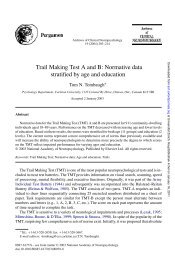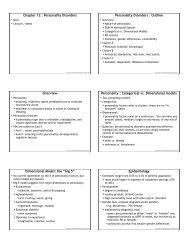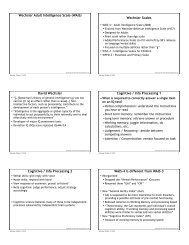Nike Shoes investigation.pdf (148 K)
Nike Shoes investigation.pdf (148 K)
Nike Shoes investigation.pdf (148 K)
You also want an ePaper? Increase the reach of your titles
YUMPU automatically turns print PDFs into web optimized ePapers that Google loves.
Name ___________________________ Period _____<br />
The <strong>Nike</strong> Shoe Investigation<br />
INTRODUCTION:<br />
On May 27, 1990 the freighter Hansa Carrier, enroute from Korea to the U.S., encountered a severe North Pacific<br />
storm. During the storm, a large wave washed twenty-one shipping containers overboard. Five of these 20-metre<br />
containers held a shipment of approximately 80,000 <strong>Nike</strong> shoes ranging from children's shoes to large hiking boots.<br />
It has been estimated that four of the five containers opened into the stormy waters, releasing over 60,000 shoes<br />
into the north Pacific Ocean. The shoes washed ashore one at a time but were wearable after a scrub-down to<br />
remove barnacles, algae, and tar. Beachcombers held swap meets to find matched pairs. In this <strong>investigation</strong> we<br />
will consider the starting point for the ocean adventure these shoes had, look at the places where shoes washed<br />
ashore, then make some conclusions about the general circulation patterns in the Pacific Ocean.<br />
MATERIALS:<br />
map of north Pacific<br />
pencil/pen<br />
map of surface currents<br />
PROCEDURES:<br />
1- Number each of the data points to reflect the true chronological order.<br />
2- Plot the location of each point, in chronological order.<br />
3- Draw small, neat arrows between the points.<br />
DATA:<br />
shoe spill, May 27, 1990 48°N, 161°W<br />
250 recovered, March 26, 1991 59°N, 139°W<br />
200 recovered, May 18, 1991 55°N, 130°W<br />
100 recovered, February, 1991 53°N, 131°W<br />
200 recovered, November, 1990 49°N, 126°W<br />
200 recovered, February, 1991 47°N, 125°W<br />
150 recovered, April 4, 1991 44°N, 124°W<br />
200 recovered, May 9-10, 1991 40°N, 124°W<br />
several recovered, January, 1993<br />
19°N, 155.5°W<br />
several recovered, January, 1994<br />
32°N, 132°E
Name _________________________________________ Period ______<br />
THE NIKE SHOE INVESTIGATION<br />
Map of the Pacific Ocean
ANALYSIS OF DATA:<br />
1- Define these terms: (a) gyre (b) current (c) eddy<br />
2- By looking at the data you plotted on your map, write a sentence or two describing the general shape of the route or pathway<br />
taken by the drifting shoes.<br />
3- Write a few sentences EXPLAINING this pathway using appropriate terms from #1 above.<br />
4- Using an atlas or other reference showing the major surface currents in the Pacific Ocean, (a) List the names for each of the<br />
currents that affected the distribution of the shoes, and (b) write them on you map showing their correct location.<br />
GEOGRAPHIC AND MATH EXTENSIONS:<br />
5- Using a more detailed map or an atlas showing the Pacific Ocean with a distance scale, calculate approximately how far the<br />
shoes traveled between the point where they spilled and their first landfall.<br />
6- Considering the distance you figured in #5, and the time it took for the shoes to make their first landfall, (a) What was the<br />
speed of the current moving those shoes in kilometers per day? (b) miles per day? (c) kilometers per hour? (d) miles per hour?<br />
7- Calculate approximately how far the shoes traveled between California and Hawaii.<br />
8- Considering the distance you figured in #6, and the time it took for the shoes to move from California to Hawaii (a) What<br />
was the speed of the current moving those shoes in kilometers per day? (b) miles per day? (c) kilometers per hour? (d) miles<br />
per hour?<br />
9- Name the two surface currents you have been studying in the above questions.<br />
10- Based on your calculations, rank the two surface currents according to their speed.<br />
11- Based on the average speed of the two currents, how long would it take for plankton drifting off the coast of San Francisco<br />
to reach Santa Monica Bay?<br />
Credits:<br />
Adapted from http://seawifs.gsfc.nasa.gov/OCEAN_PLANET/ based on McRae, M., 1993. <strong>Shoes</strong> for science. Equinox<br />
Magazine, Jan/Feb 1993: 18. Davidson, K., 1992. Following footsteps of shoes lost at sea. San Francisco Examiner,<br />
February 24, 1992. Cowen, R., 1992. Following the track of 80,000 wet <strong>Nike</strong>s. Science News, September 19, 1992: 189.<br />
Ebbesmeyer, C. C., and W. J. Ingraham, 1992. Shoe spill in the North Pacific. EOS, 75(34): 361-365.
T E A C H E R ‘ S G U I D E<br />
THE NIKE SHOE INVESTIGATION<br />
Answer Key: Plot of shoe locations<br />
Major World Surface Currents - Reference Map
















